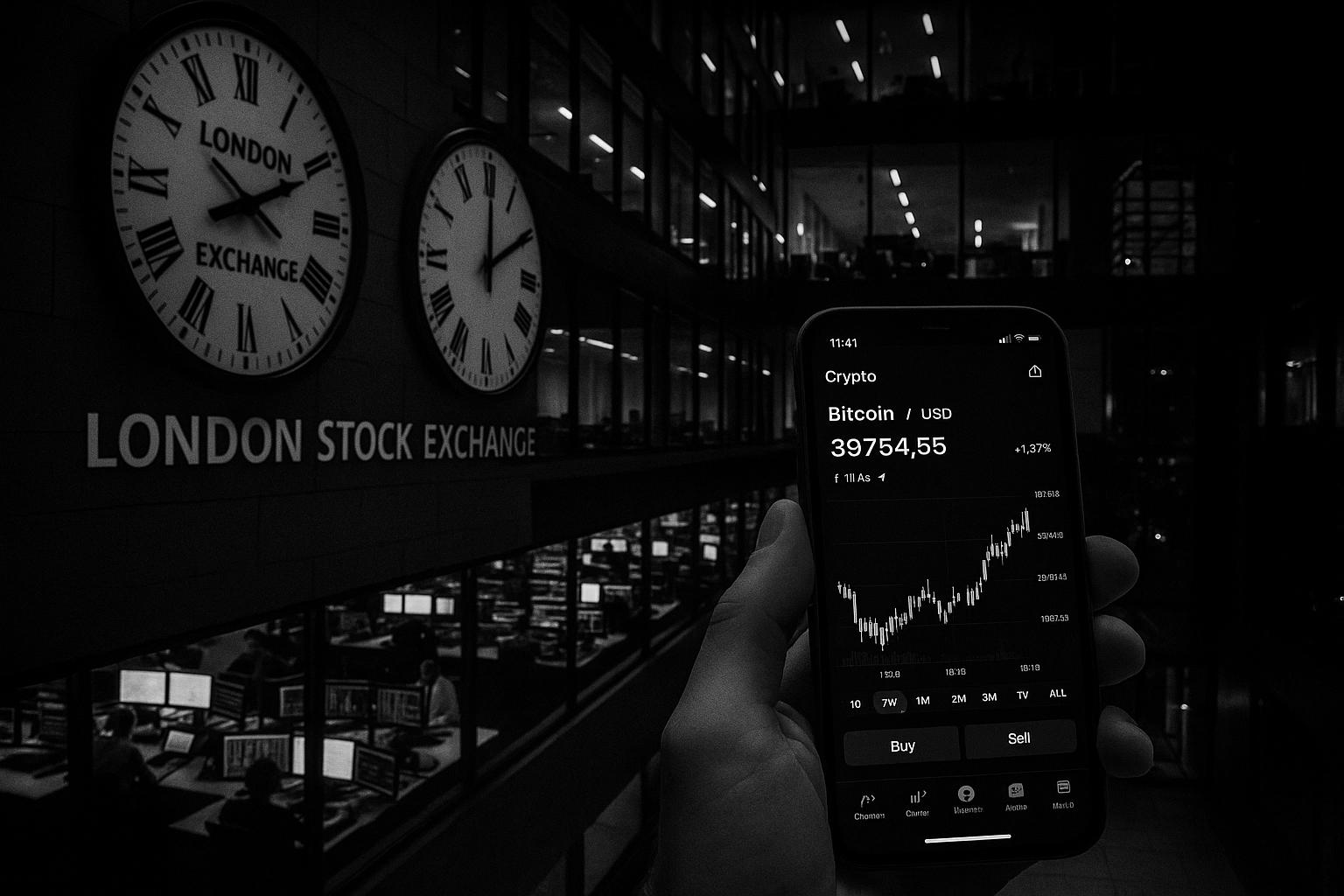The London Stock Exchange Group is investigating the potential shift to round-the-clock trading, following trends set by cryptocurrency platforms, to meet evolving demands from retail investors and enhance its global competitiveness amid regulatory and liquidity challenges.
The London Stock Exchange Group (LSEG) is actively exploring the possibility of extending its trading hours, potentially moving to a 24-hour trading model inspired by cryptocurrency markets. This initiative reflects a broader global shift as traditional exchanges seek to modernise and cater to the demands of retail investors, particularly younger traders who favour real-time access via smartphones. The continuous, round-the-clock nature of crypto markets has set new expectations for market accessibility, prompting LSEG to assess whether similar models could be viable for equities trading.
Currently, the London Stock Exchange operates from 8:00 am to 4:30 pm British Summer Time (BST), Monday through Friday, with no lunch break. It also offers pre-trading and post-trading sessions, from 5:05 am to 7:50 am and 4:40 pm to 5:15 pm respectively, providing some flexibility beyond the main trading window. Despite these extended hours, the core equities market remains confined to an 8.5-hour day, and liquidity tends to concentrate during the opening and closing auctions.
LSEG’s exploratory review involves multiple facets including the potential commercial benefits, regulatory challenges, and technological demands required to support continuous trading. The exchange earns a relatively small portion of its revenue from equities—about 2.7% in the first quarter of 2025—with most income derived from selling financial data. Nevertheless, the LSE holds a critical structural role in the City of London as a conduit for international capital into British companies, making any shift in trading hours significant for the UK’s financial ecosystem.
One of the core concerns raised both within the LSEG and across global markets is liquidity. Institutional investors and fund managers remain cautious about the implications of extended hours. They warn that liquidity tends to dwindle outside traditional trading sessions, which could undermine price discovery and increase market volatility. The risk of heightened operational costs for market participants also remains a governing factor, alongside the need for regulatory clarity to mitigate risks associated with overnight and continuous trading, such as managing market shocks and panic-driven trades during news releases.
The ambition to align trading hours more closely with global financial centres is influenced by similar moves in the United States, where exchanges like the New York Stock Exchange, Nasdaq, and Cboe Global Markets have sought regulatory approval to extend their operating hours or launch new 24-hour venues. These initiatives aim to accommodate international investors and adapt to changing patterns of global capital flows, trends that have also been expedited by Brexit-related shifts in the UK’s economic position.
A 24-hour trading platform would notably shrink the time lag for investors to respond to international events, earnings reports, and geopolitical developments, potentially enhancing London’s competitiveness on the world stage. However, LSEG faces a balancing act: extending trading times must not compromise market stability or investor protection. The success of adopting a crypto-inspired trading model depends heavily on technological readiness and a regulatory framework that supports round-the-clock operation while managing associated risks effectively.
In summary, while no official announcement has yet been made on a definitive move to 24-hour trading, the London Stock Exchange is clearly evaluating the concept within the context of accelerating global competition and evolving investor demands. The final decision will weigh potential commercial opportunities against the operational challenges and regulatory requirements to ensure that the UK’s flagship stock exchange remains a vital, modern hub in international finance.
 Reference Map:
Reference Map:
- Paragraph 1 – [1], [2], [5]
- Paragraph 2 – [3], [7]
- Paragraph 3 – [1], [2]
- Paragraph 4 – [1], [4]
- Paragraph 5 – [1], [2], [6]
- Paragraph 6 – [1], [6]
- Paragraph 7 – [1], [2], [5]
Source: Noah Wire Services
- https://cryptorank.io/news/feed/dd22d-london-stock-exchange-eyes-crypto-style-24-hour-trading – Please view link – unable to able to access data
- https://www.ft.com/content/881341a6-9b16-4051-abbe-102572868fe2 – The London Stock Exchange Group (LSEG) is exploring the feasibility of extending its trading hours to 24 hours, driven by increasing interest from retail investors who trade outside regular hours. This initiative aligns with a global trend where exchanges are modernising to meet the demands of younger investors accustomed to real-time access via smartphones. LSEG is evaluating various aspects, including technological upgrades, regulatory considerations, and the potential impact on liquidity, which is currently concentrated during the opening and closing auctions. The exchange’s equities business, despite contributing a small fraction to its revenue, remains central to London’s financial infrastructure.
- https://www.tradinghours.com/markets/lse/ – The London Stock Exchange (LSE) operates Monday through Friday from 8:00 am to 4:30 pm British Summer Time (BST), with no lunch break, amounting to 8 hours and 30 minutes of trading per day. The exchange also offers extended hours trading, including a Pre-Trading Session from 5:05 am to 7:50 am and a Post-Trading Session from 4:40 pm to 5:15 pm. These sessions allow for additional trading outside the standard hours, providing flexibility for investors.
- https://iongroup.com/blog/markets/why-are-markets-moving-to-24-hour-trading-what-challenges-lie-ahead/ – The shift towards 24-hour trading presents several challenges, including managing risk exposure, liquidity constraints after hours, increased volatility due to instant global reactions, and the risk of panic-driven trading on earnings releases. These issues necessitate rethinking market structures and trading behaviours to ensure stability and efficiency in continuous trading environments.
- https://seekingalpha.com/news/4469068-london-stock-exchange-considers-24-hour-trading-to-meet-retail-demand-ft – The London Stock Exchange Group (LSEG) is considering offering 24-hour trading to meet the growing demand from retail investors for around-the-clock market access. This move reflects a broader trend among exchanges to modernise and cater to the preferences of younger investors who are accustomed to real-time trading via smartphones. The initiative is still under evaluation, with no official announcements yet.
- https://www.ainvest.com/news/london-stock-exchange-group-24-hour-trading-ambition-break-move-uk-market-competitiveness-2507/ – The UK’s financial sector faces a stark reality: global capital flows increasingly favour markets that offer flexibility. A 24-hour LSE would reduce the time lag for international investors to react to news, earnings reports, or geopolitical shifts. However, LSEG’s move must contend with structural challenges, including reliance on institutional liquidity and regulatory hurdles. The success of this initiative hinges on technological readiness and regulatory alignment to ensure market stability and investor protection.
- https://uk.investing.com/academy/stocks/what-time-does-the-uk-london-stock-market-open-and-close// – The London Stock Exchange (LSE) operates from 8:00 am to 4:30 pm, Monday through Friday, without a lunch break. The exchange also offers after-hours trading, including a pre-trading session from 5:05 am to 7:50 am and a post-trading session from 4:40 pm to 5:15 pm. These extended hours provide additional opportunities for trading outside the standard market hours, catering to investors in different time zones.
Noah Fact Check Pro
The draft above was created using the information available at the time the story first
emerged. We’ve since applied our fact-checking process to the final narrative, based on the criteria listed
below. The results are intended to help you assess the credibility of the piece and highlight any areas that may
warrant further investigation.
Freshness check
Score:
10
Notes:
The narrative is based on a recent Financial Times report published on July 20, 2025, indicating high freshness. ([ft.com](https://www.ft.com/content/881341a6-9b16-4051-abbe-102572868fe2?utm_source=openai))
Quotes check
Score:
10
Notes:
The quotes in the narrative are directly sourced from the Financial Times report, with no earlier usage found, suggesting originality. ([ft.com](https://www.ft.com/content/881341a6-9b16-4051-abbe-102572868fe2?utm_source=openai))
Source reliability
Score:
10
Notes:
The narrative originates from the Financial Times, a reputable organisation known for its journalistic standards, enhancing the reliability of the information. ([ft.com](https://www.ft.com/content/881341a6-9b16-4051-abbe-102572868fe2?utm_source=openai))
Plausability check
Score:
10
Notes:
The claims about LSEG exploring 24-hour trading align with recent industry discussions and reports, and the narrative includes specific details such as the current trading hours and revenue contributions, supporting its plausibility. ([ft.com](https://www.ft.com/content/881341a6-9b16-4051-abbe-102572868fe2?utm_source=openai))
Overall assessment
Verdict (FAIL, OPEN, PASS): PASS
Confidence (LOW, MEDIUM, HIGH): HIGH
Summary:
The narrative is fresh, original, and sourced from a reputable organisation, with plausible claims supported by specific details.













